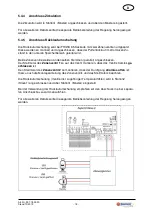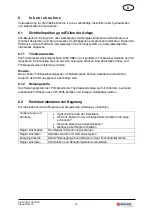
Art.-Nr. 907.75.02.00
Stand 10/2019
- 7 -
GB
Connections
HVL
Heating flow
HRL
Heating return
WW
Hot water
KW
Cold water
ZI
Circulation
4.3
Corrosion protection
To prevent corrosion damage to plate heat exchangers, the following drinking water values
must be observed:
Maximum permitted drinking water values in conjunction with stainless steel plate
heat exchangers [SS 316/1.4404]
Copper-soldered
Solid stainless steel
Chloride
1
(CL
-
)
< 250 mg/l at 50°C
< 100 mg/l at 75°C
< 10 mg/l at 90°C
Sulphate
1
(SO
4
2-
)
< 100 mg/l
< 400 mg/l
Nitrate
(NO
3
-)
< 100 mg/l
No requirement
pH value
7.5 - 9.0
6 - 10
Electrical conductivity*
(at 25°C)
10
–
500 µS/cm
No requirement
Hydrogen carbonate (HCO
3
-
)
70 -300 mg/l
No requirement
Ratio HCO
3
-
/SO
4
2-
Ratio > 1.0
No requirement
Ammonia (NH
4
+
)
< 2 mg/l
No requirement
Free chlorine gas
< 0,5 mg/l
Sulphite
< 1 mg/l
< 7 mg/l
Ammonium
< 2 mg/l
Hydrogen sulphide (H
2
S)
< 0.05 mg/l
No requirement
Free (aggressive) carbon dioxide
(CO
2
)
< 5 mg/l
No requirement
Iron (Fe)
< 0.2 mg/l
No requirement
Saturation index
-0,2 < 0 < 0,2
No requirement
Aluminium (Al)
< 0.2 mg/l
No requirement
Manganese (Mn)
< 0.1 mg/l
No requirement
Degree of hardness
4
–
14 [Ca
2+
; Mg
2+
]/ [HCO
3
-
] < 0,5
Total organic carbon
< 30 mg/l
No requirement
1
It is not permitted to use the fresh water station if the limit values are exceeded.
To prevent pitting corrosion in the domestic installation, no new galvanised iron material must
be installed downstream in the hot water pipe of the copper-soldered plate heat exchanger
without forming a protective layer.
Solid stainless steel plate heat exchangers must be used in mixed installations with zinc-
coated iron materials.
















































